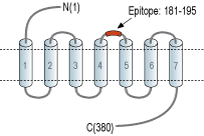Overview
- Peptide (C)EDKET(S)FDMLQMDSR, corresponding to amino acid residues 181-195 of human GPR132 (Accession Q9UNW8). 2nd extracellular loop.

 Cell surface detection of GPR132 by direct flow cytometry in live intact human THP-1 monocytic leukemia cells:___ Cells.
Cell surface detection of GPR132 by direct flow cytometry in live intact human THP-1 monocytic leukemia cells:___ Cells.
___ Cells + Rabbit IgG isotype control-FITC.
___ Cells + Anti-Human GPR132/G2A (extracellular)-FITC Antibody (#AGR-046-F), (2.5µg). Cell surface detection of GPR132 by direct flow cytometry in live intact human Raji Burkitt's lymphoma B cells:___ Cells.
Cell surface detection of GPR132 by direct flow cytometry in live intact human Raji Burkitt's lymphoma B cells:___ Cells.
___ Cells + Rabbit IgG isotype control-FITC.
___ Cells + Anti-Human GPR132/G2A (extracellular)-FITC Antibody (#AGR-046-F), (2.5µg). Multicolor flow cytometry with GPR132 and GPR68Human THP-1 monocytic leukemia cell line was labeled by adding Anti-Human GPR132/G2A (extracellular)-FITC Antibody (#AGR-046-F), (5µg) and Anti-GPR68 (OGR1) (extracellular)-APC Antibody (#AGR-042-APC), (5µg).
Multicolor flow cytometry with GPR132 and GPR68Human THP-1 monocytic leukemia cell line was labeled by adding Anti-Human GPR132/G2A (extracellular)-FITC Antibody (#AGR-046-F), (5µg) and Anti-GPR68 (OGR1) (extracellular)-APC Antibody (#AGR-042-APC), (5µg).
- Weiß, K.T. et al. (2017) Exp. Dermatol. 26, 127.
- Justus, C.R. et al. (2013) Front. Physiol. 5, 354.
- Okajima, F. (2013) Cell. Signal. 25, 2263.
G-protein coupled receptor 132, (GPR132, G2A) is classified as a member of the proton sensing G-protein coupled receptor (GPCR) subfamily. Like other members of this subfamily, i.e. GPR4, OGR1 (GPR68), and TDAG8 (GPR65), G2A is expressed on the cell surface membrane and contains seven transmembrane domains, similar to serpentine receptors. GPR132 senses changes in extracellular pH, and activation of this proton-sensing receptor by acidosis transduces multiple downstream G protein signaling pathways1.
GPR132 is expressed in a broad range of immunoregulatory cell types, including macrophages, dendritic cells, neutrophils, mast cells, T and B lymphocytes. It mediates immune cell migration as well as phagocytosis and regulates autoimmunity and lymphocyte homeostasis2.
G2A also plays a role in tumor suppression: the tumor microenvironment is acidic due to glycolytic cancer cell metabolism, hypoxia, and deficient blood perfusion and hence, G2A and other proton sensing receptors may be involved in regulation of cancer cell metastasis and proliferation. Small molecule modulators of the pH-sensing GPCRs are being actively developed and evaluated. Research on pH-sensing GPCRs provides important insights into the molecular interaction between the tumor and its acidic microenvironment and may identify new targets for cancer therapy3.
Application key:
Species reactivity key:
Anti-Human GPR132/G2A (extracellular) Antibody (#AGR-046) is a highly specific antibody directed against an extracellular epitope of the human protein. The antibody can be used in western blot and live cell flow cytometry applications. It has been designed to recognize GPR132 from human samples only. The antibody will not recognize GPR132 from mouse and rat samples.
Anti-Human GPR132/G2A (extracellular)-FITC Antibody (#AGR-046-F) is directly conjugated to fluorescein isothiocyanate (FITC) fluorophore. This conjugated antibody has been developed to be used in immunofluorescent applications such as direct flow cytometry and live cell imaging. It has been designed to recognize GPR132 from human samples only. The antibody will not recognize GPR132 from mouse and rat samples.
